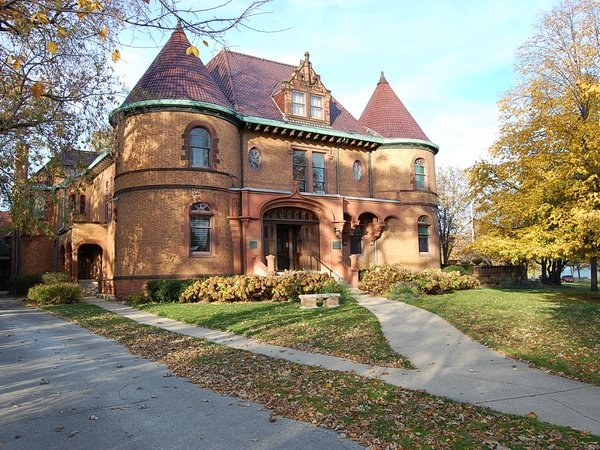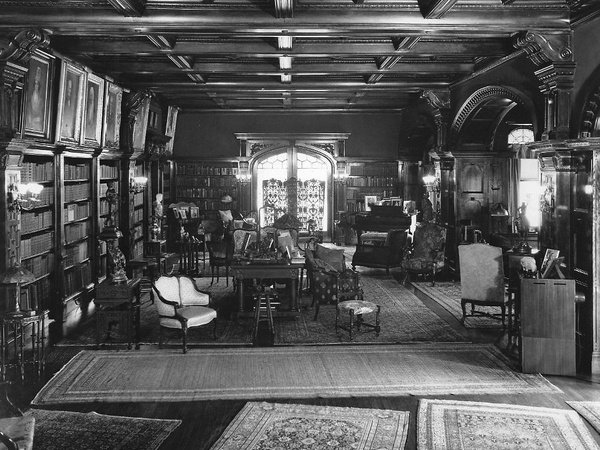Evanston History Center at the Charles Gates Dawes House
This National Historic Landmark mansion was home to 30th U.S. Vice President Charles Dawes and is now the Evanston History Center. The beautiful interior furnishings, artwork, and Tiffany lamps of the Dawes family combine with the architectural craftsmanship of architect Henry Edwards-Ficken to create an extraordinary and memorable experience.
225 Greenwood Street
Evanston, IL 60201
847-475-3410
This house museum is accessible.
This house museum is available for events.
Tours: Thu-Sun, 1, 2, & 3pm
-
French Chateauesque
The Dawes House was built in 1894 and designed by architect Henry Edwards-Ficken. Its unusual apricot-colored brick masonry exterior is adorned with elaborate and unique red sandstone ornamentation. The interior is replete with intricately carved woodwork, magnificent stained-glass windows, soaring stairways, and intriguing galleries.

-
Evanston History
The Evanston History Center houses a vast archival trove of Evanston history. From original building permits to clipping files, city directories, biographical information, organizational records, local maps, photographs, and historic books and newspapers, these objects represent a multifaceted community history.

-
Roaring ‘20s Décor
The splendor of the Dawes’ 1920s décor remains in place. Breathtaking Tiffany lamps, gilt-framed oil paintings, and many works of art grace every room. Objects on view include furniture from the White House, European antiques, countless Persian rugs, and a Steinway grand piano and several sculptures purchased at the 1893 World’s Columbian Exposition.

-
Vice President
Charles Gates Dawes was vice president under former president Calvin Coolidge from 1925 to 1929. A prominent figure in history with global reach, he was also a Nobel laureate, brigadier general in World War I, ambassador to England, comptroller of the currency, and the first federal budget director.

-
Banking
Dawes was a proficient economist. Author of a book on the U.S. banking system, the youngest comptroller of currency, and the first director of the federal budget, he wrote the revised post-war reparation plan that earned him a Nobel Peace Prize in 1925.

-
Billboard’s Top 100
In addition to his political career, Dawes was an accomplished musician and composer who played the flute and piano. His Melody in A Major was composed in this house and achieved widespread popularity. In 1951 lyrics were added and it became the song “It’s All in the Game,” which ranks 38th in Billboard’s All-Time Top 100.

-
Poverty and Homelessness
Dawes privately founded several charitable organizations to fight poverty and homelessness before governmental programs serviced the need. He and his wife Caro were also involved with adoption issues and provisions, co-founding The Cradle and serving the Illinois Children’s Home and Aid Society.

-
”Common Sense“ Politician
Dawes’s political involvement began with his work on William McKinley’s presidential campaign and carried through six presidential administrations, two World Wars, economic depression, and recovery. Running his own campaign on the slogan “Common Sense,” once in office he fought to eliminate the Senate filibuster.

-
Intertwined Relationships
The lives of the staff became intertwined with those of the Dawes family over decades. Nora and Jenny were maids, yet Nora and Charles Dawes shared stock market picks. Deedee, the governess, became Caro Dawes’s personal companion, sharing her home and lifestyle.

-
Three Staircases, Three Styles
A soaring Jacobean-style staircase of dark oak sweeps around the immense great hall. It finishes in an upstairs balcony supported with beams in which the faces of the Four Apostles are carved. The servants’ stairway is narrow and steep, while a hidden stairway to the musician’s gallery is curiously small.


